It might sound counterintuitive to work out for those who’re drained and groggy within the a.m., however analysis reveals shifting your physique is linked to higher focus and vitality. Particularly, science suggests doing high-intensity interval coaching, or HIIT.
In a February 2020 examine revealed within the journal Mind Sciences, researchers assigned individuals into two teams: One who did HIIT and one other who did moderate-intensity steady train for six weeks.
Individuals within the HIIT group carried out 15-second intervals of labor at 100% effort with 15 seconds of restoration in between. For 2 weeks, they did intervals of two units for 20 minutes every (40 minutes complete), after which the entire time was elevated to 45 minutes for the remaining 4 weeks.
In the meantime, the moderate-intensity steady train group cycled at 60 p.c effort for 34 minutes after which elevated to 39 minutes for the remaining 4 weeks.
On the finish of the experiment, the researchers ran cognitive checks and located that the HIIT group confirmed a big enhance in consideration and focus, choice making, working reminiscence, and govt operate in comparison with the moderate-intensity train group.
However you do not have to hop on a motorbike to get the advantages. Any HIIT exercise will do the trick, as long as you are pushing your self to the max and taking quick relaxation breaks.
We spoke to Miriam Shestack, CPT, a HIIT group health teacher at Equinox and private run coach in NYC, for a fast 10-minute HIIT morning exercise you possibly can strive as a substitute of hitting snooze.
In This Article
-
01
The Exercise
-
02
How To Do Every Transfer
A ten-minute morning HIIT exercise to start out your day
You will do three units of a HIIT sequence. Every set has two strikes, and you will repeat every set for 3 rounds for a complete of 10 minutes.
You will want one pair of dumbbells to carry out a few of these strikes, so decide a set that feels snug to do each upper- and lower-body workout routines. Shestack recommends selecting 10- to 15-pound weights.
Here is the lowdown:
Set 1
- 20 seconds of squat jumps
- 10 seconds relaxation
- 20 seconds of reverse lunge with biceps curl, alternating legs
- 10 seconds relaxation
Set 2
- 20 seconds of push presses
- 10 seconds relaxation
- 20 seconds of bent-over rows
- 10 seconds relaxation
Set 3
- 20 seconds of lateral lunges, alternating sides
- 10 seconds relaxation
- 20 seconds of plank jacks
- 10 seconds relaxation
Precisely how you can do every transfer with good type
1. Squat leap
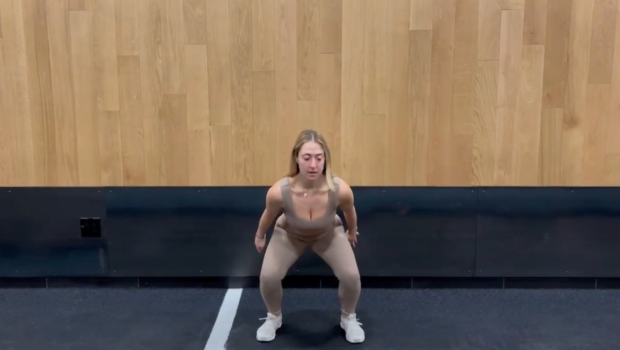
- Stand together with your toes shoulder-width aside and your toes dealing with ahead or barely outward.
- Clasp your arms in entrance of your chest.
- Brace your core and push your hips again and down till your thighs are parallel to the ground (or as little as you possibly can comfortably go).
- Push by your toes to leap explosively off the bottom. (You possibly can lengthen your arms down alongside your sides as you do.)
- Land safely together with your knees barely bent.
- Repeat for 20 seconds.
2. Reverse lunge with biceps curl
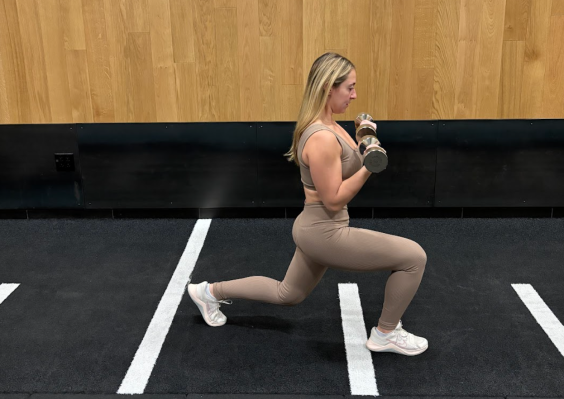
- Stand tall together with your toes hip-width aside, holding dumbbells in every hand by your sides, palms dealing with your physique.
- Step your left foot backward, then bend each knees to decrease your hips. Preserve your torso straight.
- Cease when your proper knee is at a 90-degree angle and your proper thigh is parallel to the ground.
- As you lunge, bend your elbows to curve the dumbbells towards your shoulders.
- Push by your entrance heel to return to a standing place, whereas reducing the dumbbells again right down to your sides.
- Repeat on the opposite leg, alternating sides with every rep.
- Repeat for 20 seconds.
3. Push press
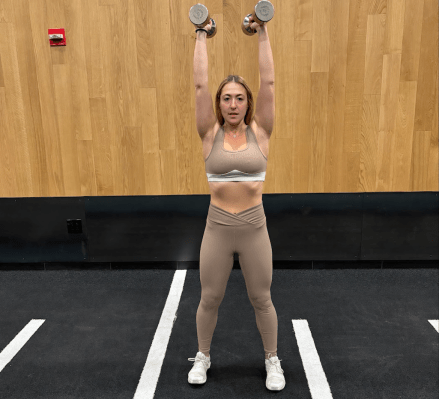
- Stand tall together with your toes hip-width aside, holding dumbbells in every hand by your sides, palms dealing with your physique.
- Raise the dumbbells as much as your shoulders.
- Bend your knees barely and dip your hips down.
- Explosively lengthen your knees and hips whereas urgent the dumbbells overhead and lock out your elbows on the prime of the motion.
- Decrease the dumbbells again to shoulder top.
- Repeat for 20 seconds.
4. Bent-over row
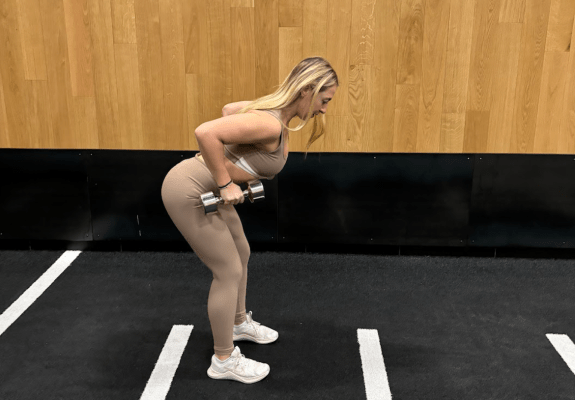
- Stand tall together with your toes hip-width aside, holding dumbbells in every hand by your sides, palms dealing with your physique.
- Bend your knees barely and hinge ahead at your hips, retaining your again flat and chest up.
- Let the dumbbells dangle straight down in direction of the ground.
- Draw your elbows up towards your ribs and pull the weights up alongside your decrease stomach. Squeeze your shoulder blades collectively.
- Decrease the dumbbells again down with management.
- Repeat for 20 seconds.
5. Lateral lunge
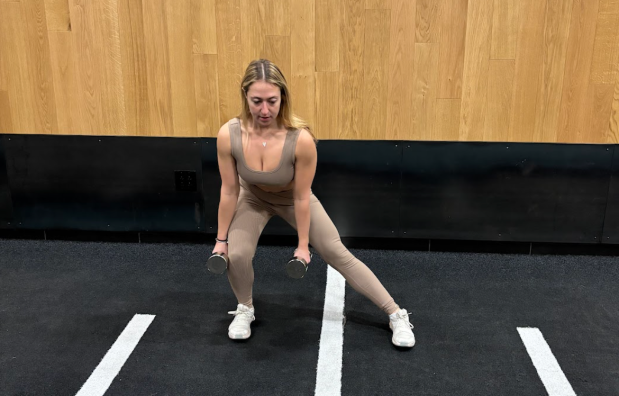
- Stand tall together with your toes hip-width aside, holding dumbbells in every hand by your sides, palms dealing with your physique.
- Take a step to the facet together with your proper foot, bend your proper knee, and decrease your physique right into a lunge, retaining your left leg straight. Preserve your chest up and again straight all through the motion.
- Push by your proper heel to return to the beginning place.
- Repeat on the opposite facet,
- Alternate legs with every rep for a complete of 20 seconds.
6. Plank jack
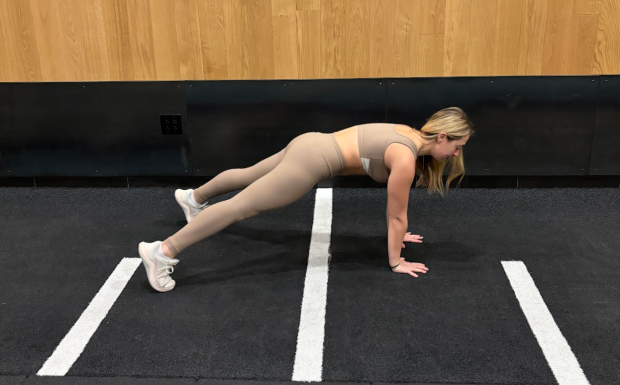
- Begin in a excessive plank place together with your arms proper below your shoulders and your physique in a straight line from head to toes.
- Have interaction your core and leap each toes out large to the edges.
- Instantly leap your toes again collectively to return to the beginning plank place. Preserve your hips secure and keep away from letting your decrease again sag or arch.
- Proceed leaping your toes out and in for 20 seconds.
Properly+Good articles reference scientific, dependable, latest, sturdy research to again up the data we share. You possibly can belief us alongside your wellness journey.
- Mekari S, Earle M, Martins R, Drisdelle S, Killen M, Bouffard-Levasseur V, Dupuy O. Impact of Excessive Depth Interval Coaching In comparison with Steady Coaching on Cognitive Efficiency in Younger Wholesome Adults: A Pilot Research. Mind Sci. 2020 Feb 4;10(2):81. doi: 10.3390/brainsci10020081. PMID: 32033006; PMCID: PMC7071608.
